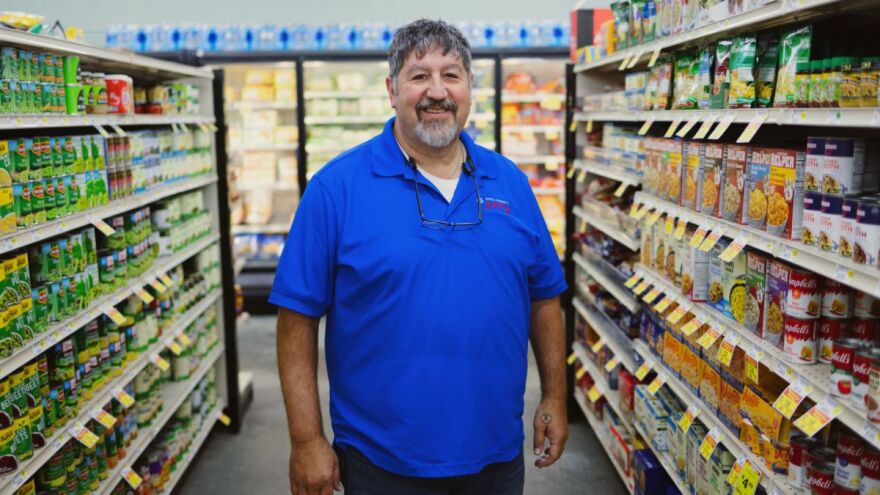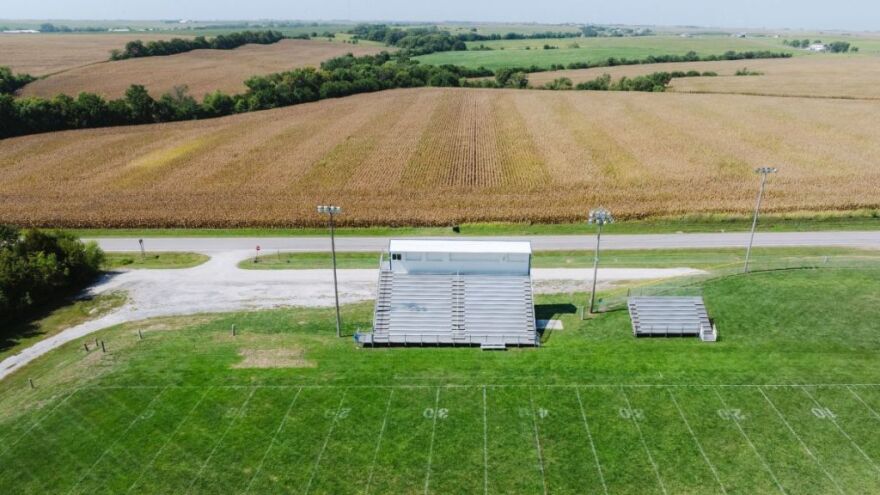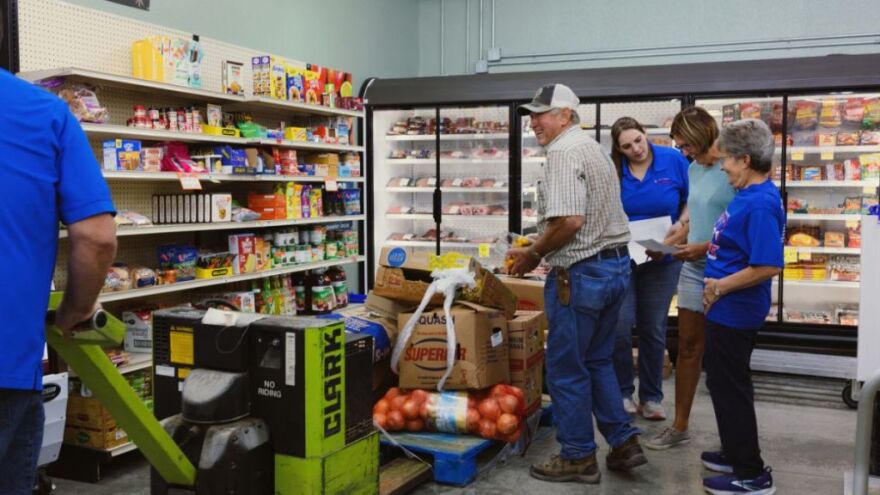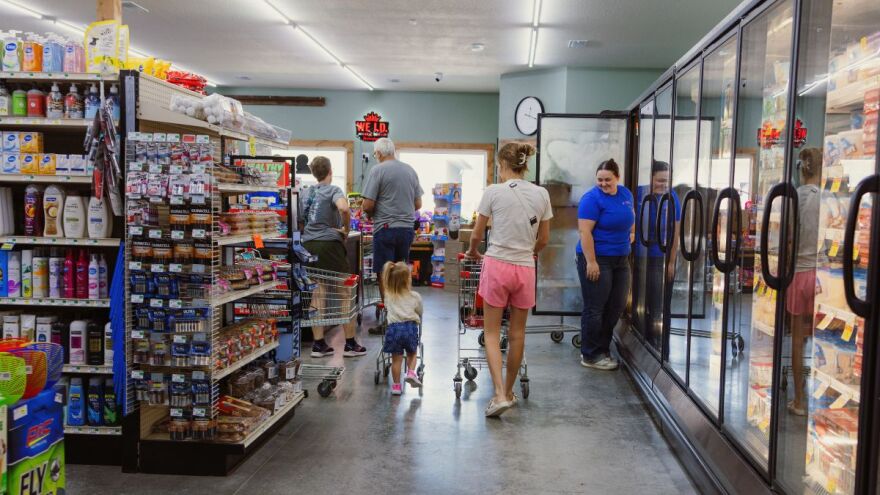AXTELL, KANSAS — When visiting his wife’s hometown of 400 in northern Kansas, Bob Lozier would joke with the owners of the grocery store that when they were ready to retire, he’d take over.
He didn’t really expect to actually take over the store — but he did.
In 2022, the owner of the only grocery store in Axtell decided to sell. The space had served as the town’s store since 1905. Suddenly, the residents of Axtell were facing a future without one.
About 40 investors, including Lozier’s wife, came together to raise nearly $500,000 to demolish and rebuild the store. They found more funding through the Kansas Healthy Food Initiative, which provides financial assistance to rural grocers. And Axtell residents donated their labor and skills to finish the project in under a year.
For Lozier, the timing worked out. His father-in-law was getting older. And leaving Tacoma, Washington, for a close-knit rural community in Kansas seemed like a great idea.
His relationship with the community has made the store a success. From the record-setting Axtell High School football team, to breakfasts for the American Legion and firefighters, Lozier makes feeding the community a priority.
“It’s more than just a little town,” Lozier said. “Everybody is family here.”
That’s just the type of community investment program the Kansas Healthy Food Initiative looks to foster across Kansas. The program is part of Kansas State University’s Rural Grocery Initiative, which aims to increase access to healthy food statewide.
Axtell Community Grocery serves as a crucial — and increasingly rare — link in the rural food chain, and community buy-in is key to its sustainability.
“That’s one piece of what we do, just to ensure that the projects we are supporting are embedded in the community and not a one-size-fits-all approach,” said Rial Carver, the rural grocery initiative’s program director.
“We’ve seen that every community varies,” Carver said. “And for a rural grocery store to be successful, it has to harness those local characteristics and local strengths.”

Kansas lost 105 rural grocery stores from 2008 to 2018, when the healthy food initiative launched. Since then, the program has awarded $5.3 million in land and grants for 75 projects in 45 counties aimed at keeping local stores open and addressing food insecurity in Kansas.
In 2023, Kansas had a food insecurity rate of 11.4%, lower than the national rate of about 14%, according to an Associated Press analysis of U.S. Census Bureau and Feeding America data. In Axtell’s Marshall County, an estimated 12.5% of county residents reported food insecurity in their household, the Associated Press analysis found.
Recently, the U.S. Department of Agriculture announced it will stop collecting and releasing statistics on food insecurity after October 2025, saying the numbers had become “overly politicized.” The decision comes in the wake of federal funding cuts for food and nutrition safety net programs nationwide.
If not for Axtell Community Grocery, the town’s residents would have a nearly 30-minute drive to get to the next closest store, which would be a major challenge for keeping and attracting young people.
“They want the young families to keep coming. They want to get bigger,” Lozier said. “This town was booming years and years ago: three grocery stores, an ice cream parlor and a movie theatre. It was big.”
Grocery stores as community anchors
U.S. Department of Agriculture research found that the median number of grocery stores per capita decreased by 40% for rural and small urban counties from 1990 to 2015, the most recent data available, while dollar stores and supercenters became more popular.
It’s a story that Blue Rapids, Kansas, knows all too well.
After a Dollar General opened down the street from the supermarket in the town of less than 1,000, the store’s owner had a warning for the community.
“Three years after Dollar General opened, the supermarket closed, which he predicted,” said Jan Bergkamp, who owns Riverside Market, a Kansas Healthy Food Initiative project in Blue Rapids.
“He warned everyone that would happen,” Bergkamp said. “And little by little, it did. Of course, we were without anything.”

At the time, Bergkamp was running a floral business with her daughter. She was approached about opening a grocery store, but had never been in the business before.
The program helped her hire a grocery consultant to run a survey of the community and help her to design the store. She also has a small deli where she serves coffee, sandwiches and baked goods, and a freezer full of premade meals.
Competition from large retailers isn’t the only thing that makes being a small grocer difficult in 2025. Other factors like affordability and proximity to customers play a large role in their success — and their impact on food insecurity in the communities they serve.
“Grocery stores have razor-thin profit margins,” said Carmen Byker Shanks, the principal research scientist at the Center for Nutrition and Health Impact. “There’s not a lot of room to sell food and make money and stay in business.”
Bergkamp’s revenue is balanced among florals, grocery and the deli counter. The store sources a few aisles of shelf-stable goods and some local products like dairy, meat and produce.
Some local products are more expensive, Bergkamp said. But her customers are willing to pay more if they know where the food is coming from.
“The items aren’t cheap, but people like them, and like where they are made,” she said.
The same is true in McCune in the southeast corner of Kansas.
Kaynee Everman stopped by McCune Farm to Market around lunchtime with her baby. She lives in town and said Walmart — about 30 minutes away — is her only other grocery option.
McCune Farm to Market includes a small grocery section on one side of the building and a restaurant on the other. Head back behind the kitchen and you’ll find a bakery.

Other grocery stores just started delivering to McCune, and Everman does use that option. But she prefers shopping locally. She’s a working mother who doesn’t have time to spend an hour driving to and from the grocery store.
“For us to be able to drive down the road is a really big deal for locals,” Everman said. “It’s fresh and it’s better quality.”
Cherie Schenker, the store’s owner, was able to at least triple produce sales because of the Kansas Healthy Food Initiative grant.
Schenker buys produce locally. There’s one pecan farmer who doesn’t have space to store all the pecans he grows, but now they sit at McCune Farm to Market. She said the massive increase in cold storage is only possible because of the KHFI grant.
“I have a friendly banker, but he’s not quite that friendly,” Schenker said.
What other resources are needed to tackle food insecurity in rural Kansas?
A grocery store is only one piece of the puzzle when it comes to addressing America’s struggle to put food on the table.
“Rural food insecurity is really driven by a lot of things,” said Byker Shanks, the nutrition researcher. “It’s a web of overlapping factors like low wages, limited job opportunities, long travel distances, aging and lack of access to social services.”
And even when small towns have a grocery store, that doesn’t always mean that families have the ability to buy fresh food.

The Kansas Healthy Food Initiative surveyed its grocers in 2021. At the time, only 4% of grocers reported that produce sales made up 15% or more of their sales. For 46% of the grocers, produce sales were anywhere between 6% to 10%, on par with industrywide averages in the Southeast and Midwest.
“I’ve visited a lot of rural grocery stores, and can say that sometimes when fresh produce is available, it’s either not affordable or it’s not something that someone would want to purchase because it’s been sitting on the shelf for so long,” Byker Shanks said.
Families and grocers push up against affordability frequently. Assistance like the Supplemental Nutrition Assistance Program (SNAP) is designed to help low-income Americans afford nutritious foods, but there’s not always a lot of uptake in rural communities because of social stigma.
“People say all of the time that it’s hard to be on SNAP in rural communities, because everyone knows our business,” Byker Shanks said.
Another common problem is many families make too much to qualify for assistance, but not enough to live comfortably.
“You watch a family and a parent work really hard to do well at their job and succeed and move up,” said April Todd, the executive director of the Pony Express Partnership for Children. “And when they do, it’s actually harmful to their family.”
Brian Walker, the president and CEO of the Kansas Food Bank, said the number of families it serves has not returned to pre-pandemic levels and they try to make their dollars stretch farther.
“What we are noticing are a lot more seniors,” Walker said. “Their fixed incomes aren’t enough to keep up with the cost of goods.”
Some community-driven solutions are underway to help families deal with food inflation. Prices for food and beverages are 25.7% higher than in 2020, according to the U.S. Bureau of Labor Statistics.
In Marshall County, a partnership between the Farm Bureau and the Pony Express Partnership for Kids resulted in four donated cows annually and anywhere from 1,200 to 2,000 pounds of ground beef that can be given away for free in the community.
Ultimately, community relationships are keeping rural grocers afloat. The question is how to scale them.
“It’s not just a business, it’s a way of life,” Lozier said. “I hear people say, ‘I could get this cheaper elsewhere,’ and I said, ‘You probably can, but remember, we’re five minutes away.’”
Associated Press data reporter Kasturi Pananjady contributed to this report. This reporting is part of a series called Sowing Resilience, a collaboration between the Institute for Nonprofit News’ Rural News Network and The Associated Press. Nine nonprofit newsrooms were involved: The Beacon, Capital B, Enlace Latino NC, Investigate Midwest, The Jefferson County Beacon, KOSU, Louisville Public Media, The Maine Monitor and MinnPost. The Rural News Network is funded by Google News Initiative and Knight Foundation, among others.






